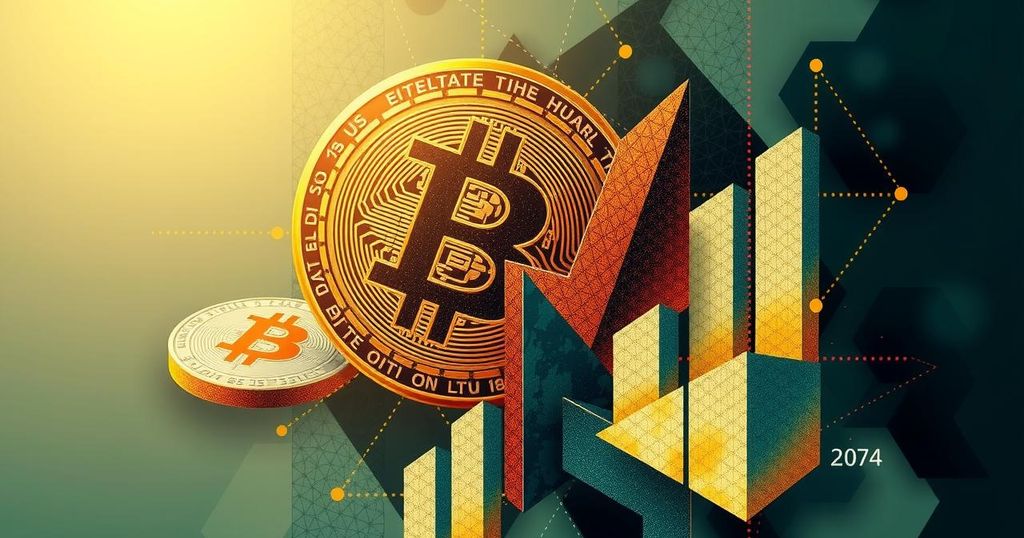Implications of Upcoming $31 Trillion U.S. Treasury Debt Auction on Bitcoin
Bitcoin is currently facing downward pressure amid macroeconomic uncertainties, with the U.S. planning to auction a record $31 trillion in Treasury debt in 2025. This scenario could significantly influence market dynamics, particularly impacting investor appeal towards cryptocurrencies. Two possible outcomes are proposed; rising interest rates could reduce crypto demand, while government debt monetisation might boost Bitcoin’s attractiveness as a hedging asset against inflation.
Bitcoin faces ongoing challenges, primarily due to macroeconomic factors as the U.S. prepares to auction an unprecedented $31 trillion in Treasury debt in 2025. Currently trading around the $80,000 mark, Bitcoin has experienced a 9.41% decline year-to-date, equating to a loss exceeding $170 billion in market valuation. The significant Treasury issuance casts doubt on the cryptocurrency’s future performance, particularly in a volatile market.
Reports indicate that the $31 trillion figure will surpass last year’s Treasury auctions, which were just under $30 trillion in 2024, and above $20 trillion in 2023. With this amount representing 109% of the projected U.S. GDP and 144% of the M2 money supply, there will be immense strain on the financial markets. Investors considering Bitcoin as a hedge might feel the effects of these substantial debt levels.
Binance Research notes that the considerable Treasury supply could significantly sway financial markets. The demand dynamics could become complex, particularly with foreign investors holding about one-third of U.S. debt. A recent report highlighted a 3.4% rise in foreign Treasury holdings to $8.817 trillion, which comprises major holders such as Japan ($1.1 trillion), China ($784 billion), and the UK ($700 billion). Any decrease in their purchasing interest could escalate financing costs and increase bond yields, consequently affecting risk assets like Bitcoin.
Two distinct scenarios for Bitcoin’s market position have been proposed. First, increasing interest rates, driven by the substantial Treasury supply, could lead to diminished interest in cryptocurrencies, as the higher yields of bonds become more enticing. Conversely, should the government decide to monetise debt by printing money for funding deficits, Bitcoin may gain traction as a hedge against currency debasement, potentially revitalising market interest.
Additionally, various macroeconomic elements are poised to shape Bitcoin’s future. Ongoing global tariff disputes contribute to economic uncertainty, while inflation currently stands at 2.5% annually, surpassing the Federal Reserve’s target of 2%. Fed Chair Jerome Powell has cautioned that these tariffs could perpetuate inflation, complicating the Fed’s objectives of stability and employment.
On April 17, Donald Trump urged Powell to lower interest rates, referencing the European Central Bank’s recent adjustment. He suggested that aligning U.S. rates with European levels could enhance competitiveness; however, Powell remained vigilant about inflationary pressures. The Fed’s current interest rate ranges from 4.25% to 4.5%, remaining steady after earlier cuts in 2024. Market predictions hint at potential rate reductions starting June 2025, possibly reaching a total cut of 1% by the year’s conclusion.
Lower interest rates typically favour risk assets, including Bitcoin, by diminishing the appeal of fixed-income investments. However, Powell’s stance on inflation persists, curbing expectations for imminent rate cuts and contributing to Bitcoin’s recent price fluctuations, which have shown resilience yet lack a definitive trajectory since April 12, trading between $86,400 and $82,700. A slight gain of 2% has been noted in April, recovering from a 2.11% decline in March and a 17.66% drop in February.




Post Comment